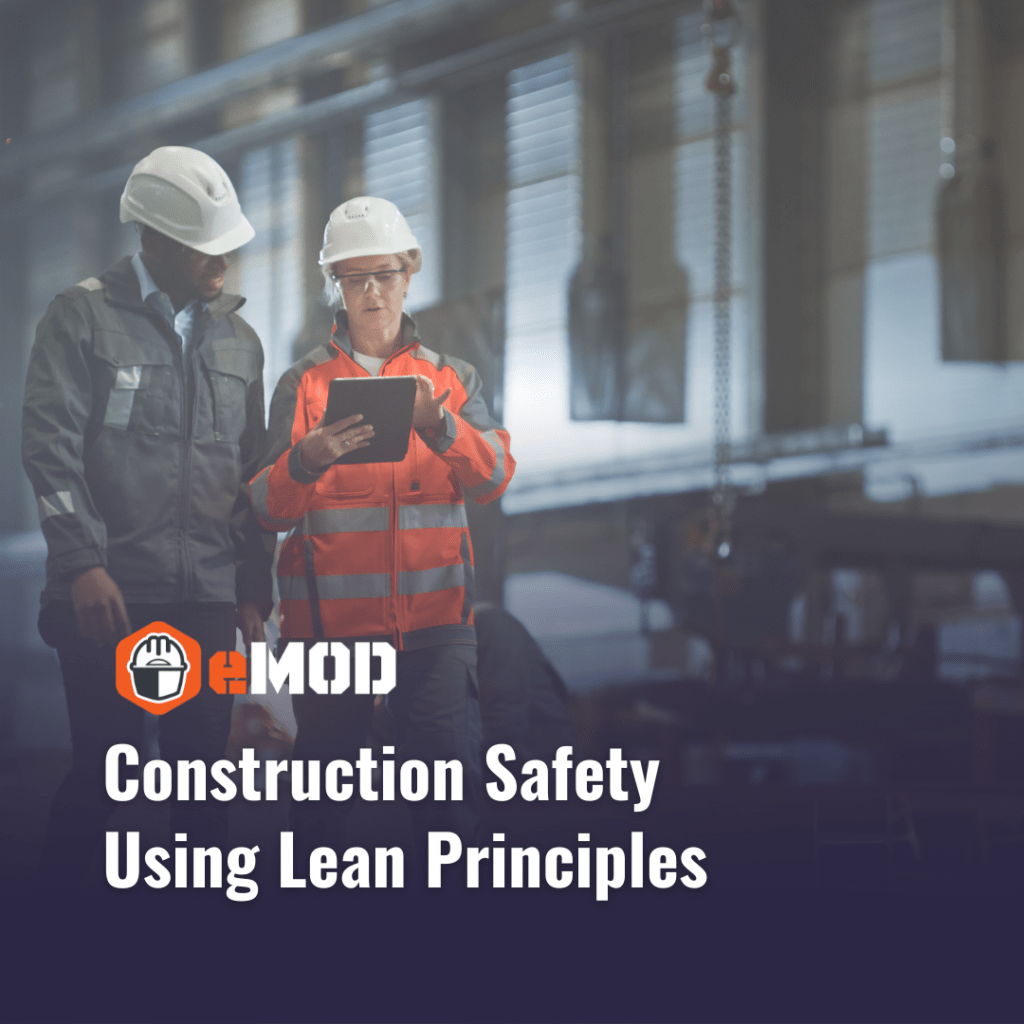
The 23rd Lean Construction Institute Congress (LCI) in Phoenix is almost upon us. LCI never fails to be one of our favorite events to attend. At LCI, industry professionals share their knowledge about construction cost-savings, efficiency, quality, and overall organizational health. Lean is breaking down organizational silos by striving for continuous improvement through collaboration. eMOD will also be there, learning from others and sharing our knowledge of merging technologies and construction safety.
With that stated, here are five ways to promote construction safety using lean principles:
1. Strive to Eliminate the 8 Wastes of Construction
Lean methodologies and tools help drive communication and continuous improvement creating a more productive and safer jobsite. This is achieved through effective planning and scheduling to create a more predictable workflow process, eliminating downtime and unproductive activities.
Lean focuses on eliminating the “eight wastes” on a jobsite. Waste is defined as any task that doesn’t add value. And, according to some studies, waste can gobble up almost half the time on a jobsite.
There are eight wastes identified in Lean construction:
- Transportation: the unnecessary movement of products and materials
- Inventory: the overproduction of excess material
- Motion: extra steps taken by people to accomplish their work
- Waiting: crews waiting for delivery of material, equipment, or completion of a preceding activity
- Overproduction: the process of fabricating material too soon or ordering extra material
- Overprocessing: unnecessary steps that create double-handling of material, double data entry, or higher quality work than is required
- Defects: incorrect work that causes rework, repairs, replacement, or inaccurate information
- Unused Employee Talent/Skills: underutilizing people’s talents, skills, knowledge, and resources
The internet is chock-full of resource sites dedicated to the eight wastes of lean construction.
2. Respect Input from Everyone Involved
Bringing people together to create shared knowledge is at the heart of lean. This goes beyond the architects, engineers, and construction leadership team sitting in a conference room. We are talking about honoring the value of what everyone brings to the table, from the CEO to skilled laborers. Listening and respecting the opinions of the entire project may unlock new efficiencies or savings that could become a best practice. When people feel respected, job satisfaction increases, workplace performance improves, and, ultimately, the jobsite becomes safer.
3. Daily Jobsite Huddles
Daily jobsite huddles are quick meetings to discuss project status, schedule priorities, and any pertinent information to start the day or shift. A huddle can help ensure everyone is on the same page that day and eliminates the wastefulness of repeating the same instructions to different groups at different times during the day. During the huddle, is a great time also to cover safety protocols, proper use of equipment, and any potential hazards on the jobsite.
The huddles should be a two-way communication where workers can also share thoughts, ideas and learn from each other. A huddle is a great time to build team camaraderie and recognize individual contributions to the group. This will increase worker engagement, which, in turn, helps workers pay more attention and be safer on the project.
4. Keeping Materials on Wheels
As mentioned, one of the eight wastes of Lean construction is mitigating transportation waste. One way to achieve this is by keeping materials on wheeled or rolling carts. With this initiative, piles of materials and equipment are transported in carts instead of workers carrying them. This saves workers from the risk of overexertion injuries, such as strains on the back and tripping on equipment or materials left on the ground. Wheeled trash receptacles also prevent debris from piling up and clogging work areas.
Utility carts, however, have their hazards such as smashed fingers and hands or the exertion of maneuvering carts. But the overall benefit of loading materials and equipment onto a cart and pushing it to the needed area often outweigh the risk of manually carrying it.
5. Just In Time Delivery (JIT)
Another “waste” previously mentioned is inventory, or the practice of stockpiling materials due to over-estimating and over-ordering. A best practice is Just In Time Delivery or JIT Delivery.
JIT Delivery balances construction resources, such as materials, equipment, and even subcontractors. To keep construction schedules intact and costs under control, these resources must be carefully planned and synchronized. Some contractors call JIT “never touching the floor,” which means materials arrive and are immediately used or installed at the site. JIT makes for a safer construction zone with fewer tripping/falling hazards and less wasted time for workers waiting for the arrival of resources.
To achieve JIT Delivery, Supply Chain Management (SCM) personnel must know all resources needed for the project and factor the lead times (both long lead and immediate) into the process. JIT Delivery requires a high level of communication and collaboration among all parties using the same cloud-based application.
6. Key Takeaway
The practice of Lean on the jobsite goes beyond driving efficiencies to save cost and improve quality. If incorporated, it can also improve jobsite safety. While eliminating waste is commonly acknowledged as a lean practice, actively engaging everyone and respecting their input is equally powerful. Using utility and hand carts to transport equipment and materials also reduces risk. Lastly, strategically coordinating the arrival of resources to create JIT Delivery provides immense value to the bottom line and for mitigating safety concerns.
We look forward to seeing you at LCI!
About eMOD
Founded in 2017, eMOD is a team of experienced commercial construction superintendents, project managers, and safety officers from a San Francisco-based general contractor. Safety is more than our passion; we’ve built a company and a product dedicated to making our industry safer. The eMOD Safety App is designed for the next generation of construction owners, insurance companies, general contractors, and trade partners. We not only built the app, we use it every day. Contact us to set up a demo today.

